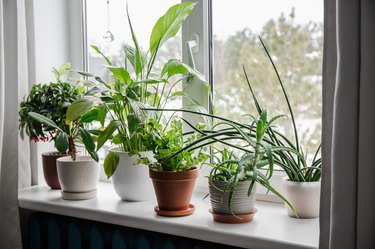
Houseplants are fickle creatures. I have had a love-hate relationship with them over the years, mostly due to lack of light, I now know. But wow—they bring life into a house and help make it a home. Fake houseplants? Bah! You may as well decorate with plastic.
If you have low light, though, choose wisely or you'll end up with a bunch of throwaways. Here are some beauties that will shine even in the almost-dark (no plants can actually grow with zero light).
Video of the Day
Video of the Day
1. Lady Palm
The aptly named lady palm (Rhapis excelsa) cuts a graceful figure and shines with a regal aura even in my north-facing living room window. The multiple stems of this palm support upright fronds that spread into fanlike segments.
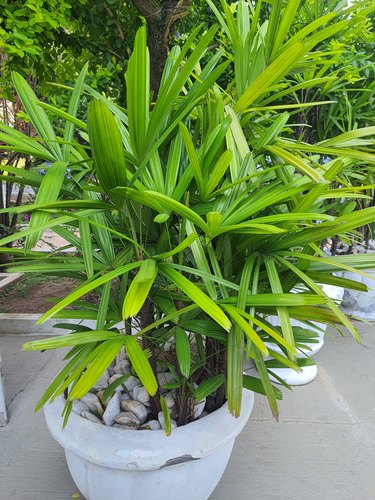
Lady palms can get large—up to 6 feet tall and wide—so watch out! Of course, plants in pots have more constrained growth, and this plant does grow slowly, but it's important to know that you can't just lop off some branches from a palm to reduce the plant's height because their new growth all sprouts from the top. You can, however, cut off individual fronds if they become brown or misshapen. This can also form the plant into a taller, more slender version of itself.
Care Tips
- Soil: Well-draining potting soil.
- Water: Requires regular watering except in winter.
- Fertilizer: Fertilize lightly with a slow-release houseplant mix during the growing season.
- Pests/disease: Mostly disease-resistant but may develop leaf spot or insect pests including mealybugs, scales, and mites.
- Temperature: Tolerant of cool air, so if the perfect place is by a door, go for it!
Note that the lady palm is also sometimes called bamboo palm, but don't confuse it with the various Chamaedorea species, which also sometimes use the common name of bamboo palm. These are entirely different plants, although many species of Chamaedorea can also tolerate low light.
2. Split-Leaf Philodendron
Bring the jungle inside with split-leaf philodendron (Thaumatophyllum bipinnatifidum, previously Philodendron selloum or Philodendron bipinnatifidum).
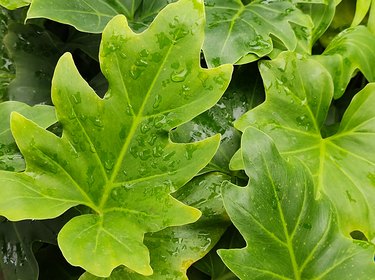
I don't currently have room for this because, like the lady palm, it's a large plant that typically reaches 4 to 6 feet tall and almost as wide. But I can picture this beauty against a white or dark wall in an entryway or some other location that will showcase its form. The cultivar Xanadu is a compact dwarf form that might work better for houseplant use.
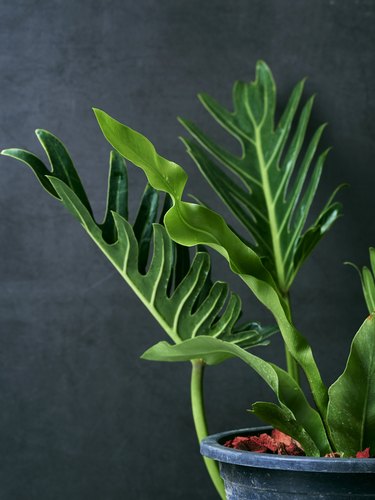
Other common names are fiddle-leaf, horsehead philodendron, red emerald, panda plant, and ... wait for it ... fruit salad plant! If you get that one, then enlighten me because this elegant plant just doesn't evoke a salad, especially one of fruit.
Care Tips
- Soil: Prefers a soil with high organic matter but is not picky about pH.
- Water: Try to use distilled water when irrigating to avoid salt buildup. Water only when the first inch of soil is dry; water less in winter. Overwatering will result in smaller leaves.
- Fertilizer: Fertilize once monthly with a slow-release houseplant fertilizer.
- Pests/disease: Mostly disease-resistant but may be susceptible to mealybugs. Also, overwatering can cause root rot.
3. Golden Pothos
Those super-glossy, heart-shaped leaves that almost glow in the dark? That's golden pothos (Epipremnum aureum). And if you have a high ceiling or want to drape its vines along your wall, feel free because pothos is that plant: the one your friends have trained along walls and over doorways. In fact, this plant can produce vines up to 40 feet long.

Golden pothos has yellow-green variegated leaves. Also called devil's ivy, this plant is among the most popular houseplants for good reason because it's super easy to grow and can last for years if treated well. A fun cultivar is Jade, which has deep dark green leaves and is the best cultivar for super-low light. A bright, almost chartreuse variety is Lime, while Neon is an even brighter yellow-green.
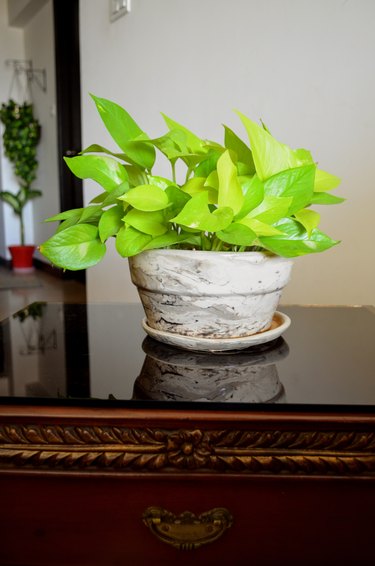
Care Tips
- Soil: Likes rich loam with good drainage.
- Water: Needs humidity, so mist the leaves regularly but be sure to let the soil dry out between waterings.
- Fertilizer: Every other month with a water-soluable houseplant mix. Stop watering in winter.
- Pests/disease: Susceptible to root rot if you overwater.
- Pruning: This plant does lose its leaves over time and can start to look spindly. When this occurs, prune back the stems to within 2 inches from the soil line, which will help the plant regain a nice bushy form.
Don't confuse pothos Jade with the plant commonly known as "jade plant" (Crassula ovata) because the jade plant requires more light and really needs a south- or east-facing window if grown indoors.
4. Lipstick Plant
This evocatively named plant has, as you might guess, red flowers as distinctive as Taylor Swift's signature lip color. Also called lipstick vine, lipstick plant (Aeschynanthus radicans) will grow just fine with very little light, although if you do have a location in your home with brighter light, it will likely flower more profusely.
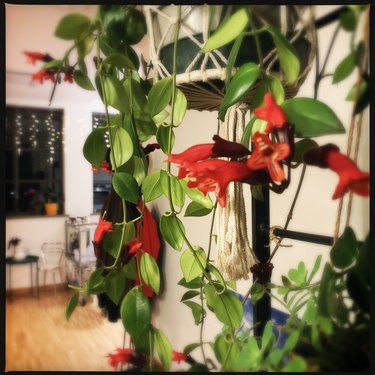
This plant's lipstick moniker isn't just because of its color; its emerging buds evoke tubes of lipstick when they first appear.
Care Tips
Soil: Any quality potting soil that drains well.
Water: Likes humidity, so misting is advised. Always mist in the morning, however, so the leaves have time to dry out.
Fertilizer: Apply a 3:1:2 slow-release liquid houseplant fertilizer during the growing season. Stop fertilizing in winter.
Pests/disease: Susceptible to aphids, mealybugs, and mites along with botrytis blight and leaf spot. Keep the leaves dry and avoid allowing them to dangle into the potting soil to avoid these fungal diseases.
Environment: Requires temperatures of 65° F
and above to flower well. Temps below 50° F
will result in leaf drop.
5. Centipede Plant
Because of its thin, dangling stems, the centipede plant (Muehlenbeckia) has attracted multiple common names, such as wire vine, maidenhair, lacy wire vine, tapeworm plant, and climbing lignum. Plop it in a hanging basket and let it cascade down where its delicate, dime-shaped leaves will shine and shimmer in any light.

I like it paired with other larger-leafed plants for contrast. For instance, here it complements a red-leaved heuchera.
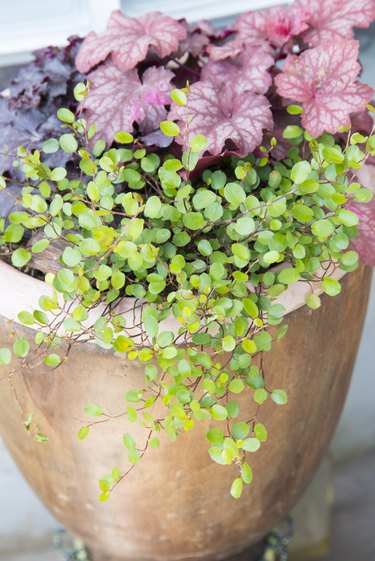
Some species of centipede plant are invasive if planted directly in the garden. In fact, some can reach 30 feet high and strangle nearby trees or even bring down branches with their weight. In the home, of course, they put on good behavior since they have no other choice! But if you are considering transplanting one of these outside, consult your local university extension office for guidance.
Care Tips
- Soil: Must have good drainage. Prefers a neutral pH (6.0 to 8.0).
- Water: Likes to dry out well before being watered.
- Fertilizer: Needs little encouragement to grow but can benefit from some slow-release houseplant fertilizer twice annually.
- Pests/disease: Susceptible to fungal diseases in poorly drained soil.
- Pruning: For too-long or spindly stems, just trim them off to encourage more bushy growth. You can use these trimmings to start new plants.
6. ZZ Plant
The ZZ plant (Zamioculcas zamiifolia) displays just about the shiniest green leaves you've ever seen. The best part, though, is that it's just about as easy-maintenance as you can get. The sweetly named ZZ plant might also be called aroid palm, emerald palm, zuzu plant, or eternity plant.
An unusual and gorgeous cultivar is the Raven ZZ (Zamioculcas zamiifolia Raven 'Dowon'), with leaves that first emerge as lime-green and then turn purple-black.
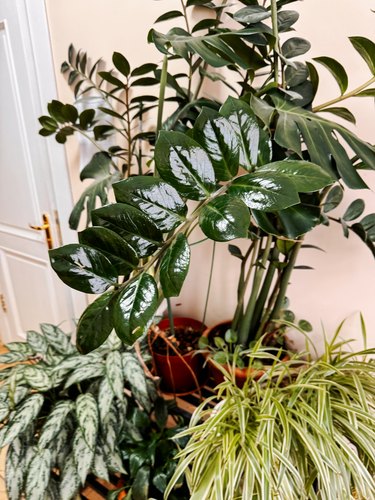
These plants have a similar care regimen as succulents or cactus in terms of water, but don't be tempted to plant this outside in the sun like you would a cactus, as the leaves will turn brown and scald in direct sunlight.
Care Tips
- Soil: Appreciates high-quality potting soil that drains well.
- Water: Water only when the soil has completely dried, usually a couple times monthly in summer. In winter, it goes dormant, so limit watering to once a month.
- Fertilizer: Balanced houseplant fertilizer twice annually.
- Pests/disease: No worries here! This plant is tough.
7. Snake Plant
The spiky leaves of the snake plant (Dracaena trifasciata, formerly Sansevieria trifasciata) create a great focal point and look amazing against softer, leafier plants. Also called mother-in-law's tongue or good luck plant, the snake plant is a super-hardy and easy-care houseplant.
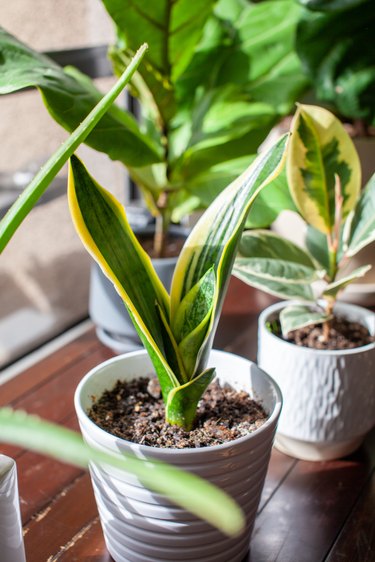
There are tons of species and cultivars to choose from. All have fabulous, sword-shaped, pointed leaves. They all grow up rather than out, so you can pretty much fit them into any small corner or space. Some are deep green, and some are variegated. Some can reach 4 feet in height, while some dwarf varieties grow like rosettes. Honestly, what a variety!

This plant is so tough that it has been known to crack a clay or ceramic pot if it gets too rootbound. It grows slowly but will need to be repotted about every five years.
Care Tips
- Soil: Well-draining soil is a must. Your best bet is to use a cactus potting mix or add perlite to existing potting soil.
- Water: Very little! Overwatering can kill this plant, so wait until the soil is dry.
- Fertilizer: Apply an all-purpose houseplant fertilizer once monthly.
- Pests/disease: Root rot will occur if it gets overwatered. It might also be targeted by mealybugs and spider mites.
8. Chinese Evergreen
The beloved houseplant Chinese evergreen (Aglaonema commutatum) has beautiful, juicy-looking variegated green leaves and can really brighten up a dark corner. Its long, narrow leaves can reach 2 feet long depending on the variety.
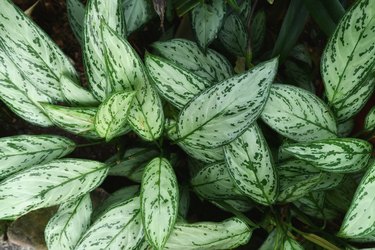
Chinese evergreen somewhat resembles dieffenbachia, another popular houseplant, but you can tell them apart by this plant's fewer (five to eight) primary lateral veins compared to those of dieffenbachia, which typically has 20 to 30. Also, Chinese evergreen leaves may appear silver-gray or even pink.
Care Tips
Soil: Rich, well-draining potting soil.
Water: Water only when the top inch of soil is dry. Generally, this plant has low water requirements.
Fertilizer: Apply a balanced houseplant fertilizer twice annually.
Pests/disease: Fairly disease-resistant but might be bothered by the typical houseplant bogeymen: aphids, spider miles, scale, or mealybugs. It hates wet feet, though, so it could develop root rot in soggy soil.
Temperature: This plant likes it warm in the 70°
to 80° F
range. Too-cold temps may result in brown leaves.
9. Peace Lily
For a really tropical look and the rare houseplant that flowers, I love the peace lily (Spathiphyllum). Its deep green leaves accented by white blooms are a standout in any location. They can be large plants, reaching from 1 foot to 4 feet in width, while some can grow 6 feet tall and wide.
In spite of its name, the peace lily is not really a lily but is a member of the same family (Araceae) as caladiums, anthuriums, elephant ears, and callas—but these grow in low light, luckily for us!
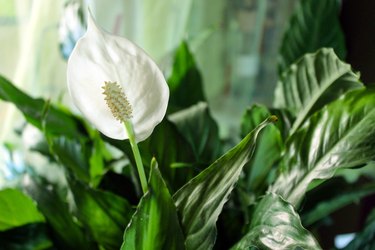
This plant flowers whenever it pleases, meaning that it doesn't wait for spring or summer but might produce flowers even during the short days of winter. These flowers appear bright white but change to a pale green after about 10 days. They'll last perhaps a month before fading.
Care Tips
Soil: Likes it moist but not soggy. Must be well-draining.
Water: Water when the soil has dried out somewhat, but very dry soil will cause plant wilt. Use room-temperature water.
Fertilizer: Very little, as too much can burn the tips of its leaves. The recommended amount is 1/4 the typical strength of a balanced houseplant fertilizer.
Pests/disease: Susceptible to stem and root fungal diseases usually caused by overwatering.
Temperature: These warm-loving plants prefer 65°
to 85° F. They don't tolerate extreme temperature changes, so shoot for no more than a 10-degree drop from daytime to night.
10. Dumbcane or Leopard Lily (Dieffenbachia)
Another common houseplant, dieffenbachia is known for its large, variegated, velvety leaves dappled with cream and yellow.
This plant's funny common names run the gamut from dumbcane to tropic snow, leopard lily, and exotica perfection. I mean, really—how can a plant called dumbcane also be called exotica perfection? But there you go.
Tip
Two species of Dieffenbachia are commonly called dumbcane: Dieffenbachia seguine and Dieffenbachia amoena. Dieffenbachia amoena can handle low light a lot better than Dieffenbachia seguine, so when you're picking out a plant for a dark corner, be sure to get the right one. The seguine species is sometimes called gold dieffenbachia or spotted dumbcane, while the amoena species is more often referred to colloquially as leopard lily.
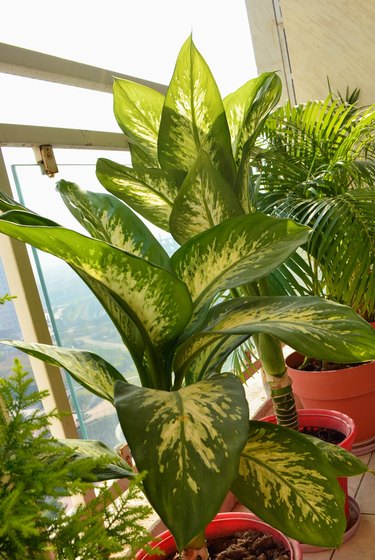
Warning
This plant has an irritating sap that can cause a burning sensation in the mouth if ingested. Keep your hands away from your mouth and eyes and always wash your hands after contact. Keep children and pets away from this plant.
Care Tips
- Soil: Fertile potting soil that must be well-draining.
- Water: Don't overwater; it hates soggy soil, so water only when the soil is dry.
- Fertilizer: Apply a balanced fertilizer, such as 20-20-20, every four to six weeks during the growing season. Too much fertilizer may cause the tips to burn.
- Pests/disease: Susceptible to various fungal rot diseases when overwatered. May also develop mealybugs or aphids.
- Temperature: This plant likes it warm and dislikes cold drafts, so protect it from extreme indoor temperature drops. If the lower leaves drop, the plant is probably in a drafty location.
Growing Houseplants in Low Light
Even though many houseplants will grow in low light, many grow faster or become more robust with somewhat brighter light. Here are a few issues to consider.
How much light is "low light"?
Low light is not just something we observe as humans when we walk into a room; it is a specific measurement using the unit footcandles (ftc), which identifies the exact light level in a location. We might think that a room or window location has plenty of light, but only the plant (or a light meter) will know for sure.
You can get a simple light meter that will tell you the footcandle measurement of any location, but here's a quick guide geared toward indoor light levels.
Indoor Light Definitions
Indoor Light Level | Footcandle (ftc) Measurement | Likely Indoor Location |
|---|---|---|
Low | 25-75 | North-facing windows |
Medium | 75-150 | South- or east-facing windows |
High | 150-1,000 | East-facing windows |
Very high | 1,000+ | East-facing windows |
What about plant placement?
The level of light in your house will change given the season, time of day, any deciduous trees you have (which will shade out more light when in full leaf), and even your wall color.
Even though a plant may be identified as one that can grow in low light, many plants may lose color or get spindly if they are continually in a very low-light environment. You might consider moving your plants around to temporarily provide them with a little more light if you notice that their health is suffering.
Should I use artificial light?
Artificial light is a great option if your plants are exhibiting symptoms due to lack of light. If you can't move plants to a south- or east-facing window, consider full-spectrum artificial LED lights. This type of lighting incorporates both red and blue light, both required by plants for optimum growth.
Be sure to position the lights close to your plant. You'll know if the light is close enough if your plant looks healthy and robust as opposed to off-color and too leggy. In addition, turn off the light after about 12 hours because all plants need time to rest. Using a timer can help with this.